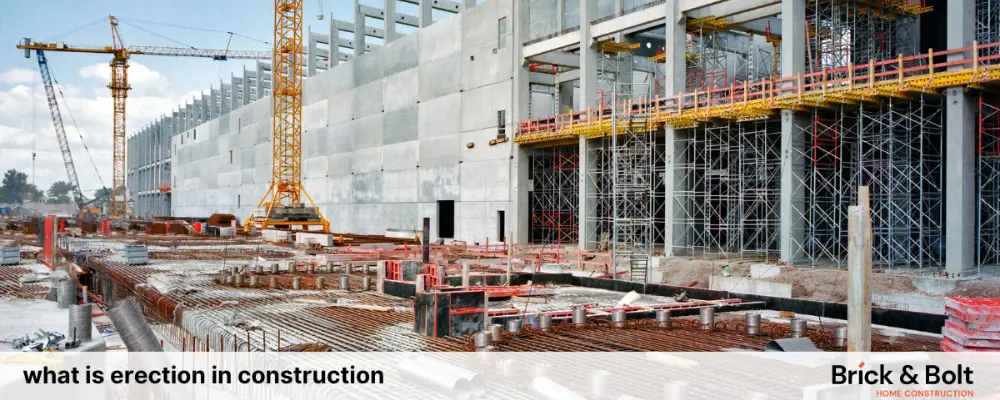Erection in construction refers to the process of assembling, aligning, or installing building elements, making any alterations, or repairing building components in the site using pre-manufactured parts such as steel frames, concrete elements, and mechanical parts. The term is generally used to denote the execution of steel structures.
Difference Between Construction and Erection
Both the terms construction and erection are generally used interchangeably and are related to each other. But both are different processes. Construction is a complete process that starts with site evaluation, excavation, planning and designing, and finishing the project. On the other hand, erection refers to the installation and mounting of pre-manufactured parts after site preparation and completion of foundation work.
Advantages of Erection in Construction
- Faster Project Completion: Erection can speed up construction projects since it involves assembling pre-manufactured parts on-site.
- Improved Quality: Erection involves the assembling of components manufactured in a controlled environment with high quality and industrial standards.
- Enhanced Safety: Erection prevents injuries or accidents on-site as components are assembled on the ground or in a factory.
- Reduced Waste: Erection minimises material wastage, unlike traditional construction, as components are manufactured to exact specifications and requirements.
- Cost Savings: Erection speeds up construction projects, reducing labour costs and other waste generation.
Types of Erection in Construction
Steel Structure Erection:
Steel structures have the capacity for bearing large loads in buildings and bridges. The construction of buildings, bridges, aircraft hangars, auditoriums, warehouses, towers, and power plants using steel structures with the help of welding and bolting tools is known as steel erection. Steel erection is usually done with the help of cranes, rigging equipment such as pulleys, slings, and shackles to move steel structures, and welders to connect the steel components. This process involves making steel roofing and siding, constructing steel columns and beams, and installing handles and staircases in steel frames.
Mechanical Erection:
Mechanical erection means setting up and aligning mechanical equipment like engines, motors, compressors, pipelines, turbines, and food processing machines such as mixers and blenders. It also includes installing equipment that helps transfer power, along with other industrial machines. This process usually takes place in large industrial areas like power plants, oil refineries, mining sites, chemical plants, and aerospace facilities. A good example of mechanical erection is installing HVAC systems (Heating, Ventilation, and Air Conditioning) like furnaces, boilers, fans, and cooling towers in factories, commercial buildings, and power plants.
Hybrid Materials Erection:
This is the process of installing ready-made components such as door frames, wall panels, windows, pre-made concrete elements, staircases, electrical parts, kitchen cabinets and countertops, and other interior features to achieve a high-quality finish. This process should be carried out carefully according to the design and specifications.
Precast Concrete Erection:
This technique involves manufacturing concrete components such as walls, floors, and roofs in a factory and transporting them to the site. These precast components are assembled on-site to form a structure. They provide accuracy, durability, quality, and faster construction.
Wood Structure Erection:
Wood erection refers to the process of fabricating and mounting wood components, such as frames, columns, and beams, to form the structural support system for a building.It can add a warm, natural, and rustic appearance to a building. Additionally, it has a high strength-to-weight ratio and can withstand heavy loads. But wood requires extra protection from moisture to prevent decay and damage from pests.
Erection Process
Planning and preparation:
Before starting a work, it is important to review the designs and requirements. It is necessary to create a proper timeline for the erection process and visit the site for inspections.
Safety measures:
The system of erection involves installing huge building components. Therefore, it is important to take safety and precautionary measures to protect workers, engineers, and people near the site area.
Materials delivery and storage:
Safe transportation of building elements to the site area and evaluating site conditions for handling this is vital. Store the materials in an organised way in the provided storage areas.
Assembly and installation:
This is the critical phase of the erection process, as it involves setting up building frames and structures using cranes, pulleys, slings, hooks, and other equipment to lift heavy loads.
Quality control and inspection:
This is the process of checking the assembled structures to see if they meet the required standards, parameters, and safety protocols by examining the dimensions, placements, and overall quality
Erection Techniques and Methods
Stick built process:
This is a conventional way of installing a building structure piece by piece on the construction site. It is a flexible way of construction, which allows for individual element modification during the process.
Modular construction:
In this method, building frames and structures are assembled in a factory and transported to site for erection or installation. It results in less waste, improved and controlled quality, and time savings.
Safety Measures
- Ensure the safety of workers by providing them with personal protective equipment such as harnesses, gloves, hard hats, safety glasses, and safety shoes.
- Prevent accidents and falls from heights by implementing protection measures like installing safety nets and using scaffolding and barriers.
- Use rigging and lifting equipment that is in good condition and make sure operators are trained and certified.
- Careful handling of materials is a must to prevent damages or falling objects.
- Engineers should monitor weather conditions and need to stop the work during heavy winds, thunderstorms, or rain.
- Establish communication guidelines among workers, engineers, and contractors to avoid misunderstandings and confusion.
- Make sure proper electrical wiring, grounding, and insulation is done to prevent electrical shocks.
Conclusion:
An efficient and successful erection process is based on careful planning, execution, and management. By considering various methods, techniques, selection of materials, safety measures, and cost factors, it is possible to achieve a high-quality, effective, and safe erection process in construction projects.
FAQs
It includes improved quality, enhanced safety, increased productivity, and reduced project timelines.
Yes, erection can be done in phases to cater to project requirements, financial needs, and timelines.

